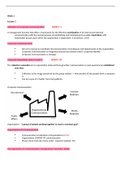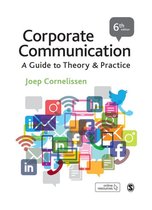Week 1
Lecture 1
Definition of Corporate Communication BOOK P. 5
A management function that offers a framework for the effective coordination of all internal and external
communication with the overall purpose of establishing and maintaining favourable reputations with
stakeholder groups upon which the organization is dependent. (Cornelissen, 2017)
Corporate Communication:
Aim is to oversee & coordinate all communication of employees and departments of the organization
Corporate Communication is integrated around one mission/vision/ corporate identity
Corporate Communication is strategic
Corporate Reputation (also in week 2) BOOK P. 85
The collective evaluation of an organization (induced through either communication or past experiences) established
over time.
Collective as the image perceived by the group matters -> how positive all the people think a company
is
Can be a type of a 'buffer' form bad publicity
Corporate Communication
Organization - "a group of people working together to reach a common goal"
Organisations AS Communication
Communicative Constitution of Organizations (CCO)
Organizations CONSIST OF communication
Please check YouTube movie under ‘required readings’ W1
Five approaches to communication management (Van Ruler, 2005):
, Informative approach
Just information transition from sender to receiver
One-way line of the communication
Basic, receiver unpacks the information as intended by the sender
Your aim is to reach people
Persuasive approach
Intended to have some effect on people
We want to get certain approach to peoples minds
Either in terms of behaviour or thinking
You don’t want to just reach people, you want to get some results
People who have a strong attitude -> experience less of a effect of communication
E.g. using with marketing and pretesting
Relational approach
Communication contributes towards forming a relationship between actors
Both parties should be willing to keep the others interest in mind
Trust is created
Interpretative approach
Each actor is both sender and receiver
Based on social constructivism
Devotes attention to the meanings people construct through communication
What people see and know about reality -> construction of a mind, derived from
communication (including reading, watching and listening, media, etc. )
We all have different ideas about this organization -> through communication we construct
images of those constructs combined with others people images.
E.g. although produced to serve with a particular meaning people can adapt a product to suits
their needs -> e.g. like the development of Netflix
Critical approach
Normative theory -> what should communication look like (others state what is looks like)
, Takes into consideration power structures - communication can establish power (e.g. yellow
jackets riots in Paris)
Contribute to the society that is open for new ideas
Historic Development of Corporate Communication:
What kind of society are you establishing through communication?
Power inequalities
Before 1970s - large emphasis on reaching the audience and getting the message to them and further
After that marketing came up, increasing the desire to change peoples attitudes towards brands and
certain ideas
After 2000s- companies want a relationship with stakeholders-> more efficient, less use of mass
media, engaging in a dialogue
Large emphasis on engagement and building trust
The Environment of Organizations
Stakeholders & Issues
Assessing the relationships , how an organization relates with different parties in the environment.
Input - output model BOOK P. 63
Organization is the centre of economy, each contributor of inputs is rewarded witch appropriate
compensation and as a result of competition throughout the system the bulk of benefits will go to
customers
, Power lies with the organization on which the other parties are dependent and their relationship to the
organization is only financial
Stakeholder theory BOOK P. 63/4
Mutual dependencies between organizations and various stakeholders groups - groups that are affected by operations
of the organization, but can equally affect organization, its operation and performance
Taking into consideration more parties in the environment of the company
Two-way relationships -> recognizing that the need and dependence along with profits and benefits
happens both ways
Instrumental (prescribes that when you deal with all those stakeholders in an effective manner you
will be more successful)
Stakeholder BOOK P. 64
Each group, or individual that can influence or is influenced by the behaviour of the organization. (Freeman, 1984)
E.g. investors, customers, suppliers, employees - most important to have a good relationship with
But there are so much more parties - stakeholder theory
Stake BOOK P. 64
An interest (belang in Dutch) or stake in a corporation, which can vary from personal interest to ownership of the
organization’ (Carroll, 1996).
Categorize the stakeholders and asses their importance
Stakeholder salience model: BOOK P. 67, 68, 69
How much power, legitimacy and urgency a
stakeholder has over the organization
Based on that an organization assesses how important
a stakeholder is for the organization and how they
should communicate with them
Most important a definitive stakeholder
Needs constant reanalysis and recalculations






